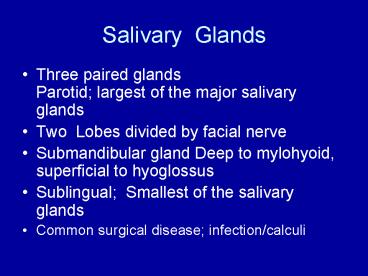Salivary Glands - PowerPoint PPT Presentation
1 / 23
Title:
Salivary Glands
Description:
Surgical, debilitated patients. Staphylococcus. Swollen, painful parotid glands ... Common in glass blowers/wind instruments musicians, etc. Neck swellings. Tumours ... – PowerPoint PPT presentation
Number of Views:1553
Avg rating:3.0/5.0
Title: Salivary Glands
1
Salivary Glands
- Three paired glandsParotid largest of the major
salivary glands - Two Lobes divided by facial nerve
- Submandibular gland Deep to mylohyoid,
superficial to hyoglossus - Sublingual Smallest of the salivary glands
- Common surgical disease infection/calculi
2
Salivary GlandsBenign conditions
- Mumps
- Acute painful parotitis
- Viral in aetiology
- Self limiting
- Mikuliczs Syndrome
- Bilateral enlargement of salivary lacrimal
glands - Sjogrens Syndrome
- Triad of dry eyes, dry mouth, dry joints
- Autoimmune
- Lymphocytic infiltration
- Pyogenic parotitis
- Surgical, debilitated patients
- Staphylococcus
- Swollen, painful parotid glands
- Pus from stensens duct
3
Salivary glandsBenign Tumours
- Comprise 3 - 6 of all head neck tumours
- Pleomorphic Adenoma
- Commonest tumour (53 - 71)
- Slowly growing, painless, solitary, firm, smooth,
moveable without nerve involvement - Both mesenchymal/epithelial elements
- FNA, CT, MRI
- Superficial parotidectomy
4
Salivary GlandsTumours
- Warthins tumour(adenolymphoma, papillary
cystadenoma lymphomatosum) - 6 - 10
- Benign, bilateral, parotid gland only,
- Older age group
- Superficial location
- Malignant potential non existent
5
Salivary GlandsMalignantTumours
- Locally aggressive
- Grow along neural pathways, may access skull base
and brain eventually - Also lymphatic and haematogenous spread
6
Salivary GalndsMalignant Tumours
- Mucoepidermoid Carcinoma
- Commonest malignant tumour
- 50 of all salivary gland malignancies
- Parotid involved in 40 - 50
- 75 are low grade have good prognosis
- 1 5 year survival 85
- High grade mucoepidermoid carcinomas invade
locally, spread regionally distant mets - 5 year survival drops 30
7
Salivary Glands
- Adenocystic carcinoma(Cylindroma)
- Commonly involves submandibular (35 - 40), only
7 of parotid malignancies - Slowly growing
- Perineural invasion
- 30 lymph node mets, 50 distant mets
- 5 year survival 75
- 10 year survival 30
- 20 year survival 13
8
Salivary Glands
- Mixed malignant tumour
- Long standing pleomorphic adenoma
- Older age group
- Worse prognosis
- Lymph node mets 15
- Distant mets 30
- 5 year survival 40 - 50
- 15 year survival 20
9
Salivary Glands
- Acinic cell carcinoma
- Low grade
- Slow growing
- 10 of malignant parotid tumour
- Lymph node mets 10
- Aggressive tumours
- Radical parotidectomy
10
Salivary Glands
- Squamous cell carcinomas
- Infrequent occurrence 1 - 5
- May have skin infiltration
- Total radical parotidectomy_
11
Salivary GlandsEvaluation Diagnosis
- History clinical examination
- Sialography of no value
- CT scans
- CT sialography for retromandibular/parapharayngeal
- MRI
- Incisional biopsy containdicated
- FNAC
12
Salivary GlandsStaging System
- T0 no clinical evidence of primary tumour
- T1 0.1 2.0 cms diameter without significant
local extension - T2 2.1 4 cms without local extension
- T3 4.1 6.0 cms without local extension
- T4a gt6 cms without local extension
- T4b tumour of any size with significant extension
13
Salivary GlandsStaging system
- N0 no evidence of regional nodal involvement
- N1 evidence of regional nodal involvement
- Nx regional nodes not assessed
- M0 no distant mets
- M1 distant mets eg., bone, lung, etc.
14
Salivary GlandsSurgical complications
- Flap necrosis
- Seromas haematomas
- Oropharangeal cutaneous fistulas
- Carotid rupture
- Thoracic duct fistula
- Pneumothorax
- Airway obstruction, dysphagia, oedema, loss of
tongue mobility, superoir laryngeal nerve damage
15
Neck swellingsDifferential diagnosis
- Neck divided into ant. And posterior triangle by
sternocleidomastoid - Cervical lymphadenopathy commonest cause of neck
swelling
16
Neck SwellingsD/D (benign)
- Congenital swellings branchial cleft swellings,
thyroglossal duct cyst, laryngocoele,
haemangiomas, cystic hygromas, dermoid. - Inflammatory acute chronic lymphadenitis(
infectious mononucleosis, toxoplasmosis, cat
scratch fever, actinomycosis, histoplasmosis,
tuberculosis - traumatic aneurysms, av malformation,
torticollis, etc - Pharyngeal pouch, cervical ribs, thyroid, etc
17
Neck swellings
- Branchial cleft cyst
- Remnants of incompletely obliterated branchial
clefts/pouches - Located anterior deep to sternomastoid
- Painless swelling
- Young adults
- M F ratio
- Unilateral, 75 on left side
18
Neck swellings
- Thyroglossal duct cyst
- 70 of all congenital cysts
- Arrested migration of thyroid
- Painless midline swelling
- Sistrunk operation
19
Neck swellings
- Csytic hygroma
- Collection of lymph sacs
- Present at the root of neck(post. Triangle), arm,
groin. - Pharyngeal pouch
- Pulsion divertuculum
- Uncoordinated swallowing
- Sternomastoid tumour
- Birth trauma, infarcted segment , fibrosis,
torticollis
20
Neck swellings
- Cervical rib
- Extra cervical rib
- lt 1 population
- Neurological and vascular problems
- Ranula
- Mucous containing cyst in floor of mouth
- Painless midline, spherical, smooth, fluctuant,
transillumanant - Dermoid cyst
- Midline, asymtomatic, painful when infected
- Laryngocoele
- Diverticulum of laryngeal ventricle
- Lined by epithelium
- Common in glass blowers/wind instruments
musicians, etc
21
Neck swellingsTumours
- Benign Carotid body tumour, lipoma, soft tissue
tumour - Malignant skin tumours( SCC, BCC, melanomas),
thyroid tumours, salivary gland tumours - Carotid body tumour
- Sporadic occurrence 90
- Familial 10
- Unilateral, but bilateral/multicentric 10
sporadic, 50 bilateral familial - Grows 0.5 cms/year
22
Schedule of Lectures V Med
- Salivary glands Neck Swellings
- Skin soft tissue tumours
- Benign Malignant breast diseases
- Thyroid, parathyroid disorders, carcinoid,
phaechromocytoma, MEN syndrome - Oesophageal gastric disorders
- Small bowel obstruction, Crohns disease,
meckels, etc - Colon rectal diseases
- Hepatobiliary disorders
23
Lectures
- Pancreatic disorders
- Hernias
- Arterial venous disorders
- Osteoarthritis Rheumatoid arthritis
- Fluid electrolyte balance, nutrition
- Preoperative preparation, haemostasis blood
transfusion - Trauma burn Management
- Common urological problems
- Common orthopaedic problems
- Common cardiothoracic problems
- Common neurosurgical problems































